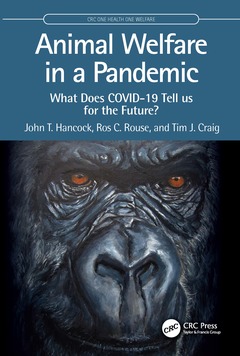Animal Welfare in a Pandemic What Does COVID-19 Tell us for the Future? CRC One Health One Welfare Series
Auteurs : Hancock John T., Rouse Ros C., Craig Tim J.

Animal Welfare in a Pandemic explores the impact of COVID-19 on a wide array of animals, from those in the wild to companion and captive animals. During the height of the pandemic, a range of animals were infected, and many died, but this was hard to predict, even using up-to-date bioinformatics. Lockdowns around the world had, and continue to have, a major effect on animals? welfare, influencing pet ownership and care, as well as impacting on the work of conservation institutes due to the lack of visitors and funding and lack of tourist presence in the wild which impacted on anti-poaching efforts. Some of the vast amount of personal protection equipment (PPE) that was distributed was discarded, creating both dangers and occasional opportunities for wild animals. With the rollout of human vaccines, some countries started developing animal vaccines, only some of which were deployed. In summary, the pandemic had a wide-ranging influence on animal welfare around the world. This is reviewed to highlight what can be learned to protect and enhance animal welfare in future epidemics/pandemics, and contribute to a genuinely One Health approach where the health and welfare of both humans and animals are considered holistically.
This book is authored by members of the University of the West of England, Bristol, who span a range of expertise in Biological Sciences, Social Sciences, Animal Welfare, and Ethics.
Dedication
Acknowledgements
Preface
Author Biographies
Chapter 1: The Coronavirus Disease 2019 (COVID-19) Pandemic
Chapter 2: Can the Susceptibility of Animals to SARS-CoV-2 be Predicted?
Chapter 3: Animals Which Were Infected in the Real World
Chapter 4: Animal Vaccines
Chapter 5: Animal Conservation and the Pandemic
Chapter 6: The Indirect Effects of COVID-19 on Animals
Chapter 7: Animals, Pandemics and the Future
Chapter 8: Final thoughts
Index
John T. Hancock is Professor of Cell Signalling at the University of West of England, Bristol (UWE) UK. He studied at the University of Bristol where he obtained a BSc(Hons) in Biochemistry (1984) and then a PhD (1987). He stayed at Bristol where he held post-doctoral research positions for six years, before he moved to UWE in 1993. He has been at UWE ever since. John has a long-standing interest in how small relatively reactive molecules are able to partake in cell signalling events in cells. This often centres around the chemistry of reduction and oxidation (redox). He has authored several editions of the textbook Cell Signalling, published by Oxford University Press, as well as publishing over two hundred academic articles. He holds several editorial positions with journals, most notably being the Editor-in-Chief of the journal Oxygen. Recently, John has published the book Why Elephants Cry: How Observing Unusual Animal Behaviours Can Predict the Weather (and other Environmental Phenomena) with CRC Press. He has also written several articles on COVID-19, including about the impact of the pandemic on animals and animal welfare, and it was this which initiated the writing of this book.
Tim J. Craig originally studied Molecular and Cellular Biochemistry at the University of Oxford, graduating in 2000, before studying for a PhD at the University of Liverpool on the molecular mechanisms of neurotransmitter release. His first postdoctoral position was in ion channel physiology at the University of Oxford (2004-2009) followed by a senior postdoctoral position at the University of Bristol (2009-2015), during which he worked on many aspects of molecular neuroscience, including synaptic plasticity and neurotransmitter release. Since 2015, he has had an academic position at the University of the West of England, Bristol, where he is currently an Associate Professor of Neuroscience. In this role he teaches on many different
Date de parution : 04-2024
15.2x22.9 cm
Thèmes d’Animal Welfare in a Pandemic :
Mots-clés :
Animals; Bioinformatics; Conservation; COVID-19/SARS-CoV-2; PPE; Vaccines; One Medicine; One Health; Welfare; Pandemic



